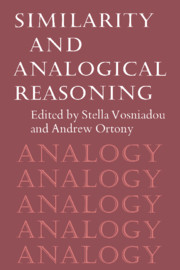Book contents
- Frontmatter
- Contents
- Preface
- List of contributors
- Similarity and analogical reasoning: a synthesis
- Part I Similarity and the structure of concepts
- Part II Analogical reasoning
- Part III Similarity and analogy in development, learning, and instruction
- Afterword: Comments on Parts I, II, and III: A framework for a theory of comparison and mapping
- Name index
- Subject index
Part I - Similarity and the structure of concepts
Published online by Cambridge University Press: 22 October 2009
- Frontmatter
- Contents
- Preface
- List of contributors
- Similarity and analogical reasoning: a synthesis
- Part I Similarity and the structure of concepts
- Part II Analogical reasoning
- Part III Similarity and analogy in development, learning, and instruction
- Afterword: Comments on Parts I, II, and III: A framework for a theory of comparison and mapping
- Name index
- Subject index
Summary
The contributions included in Part I have something to say either about similarity itself or about how people's conceptual representations affect similarity judgments. The papers by Lance Rips and by Edward Smith and Daniel Osherson look at similarity from the point of view of the role it plays in other psychological processes, like categorization and decision making. Rips argues that, although similarity may provide some cues to an object's category identity, it fails to provide an adequate explanation of people's category judgments. In contrast, Smith and Osherson believe that similarity plays an important role in decision making. They propose an explicit model wherein a person estimates the probability that an object belongs to a certain class by relying on the similarity the object bears to a prototype of the class. Linda Smith discusses the issue of how the complex system of similarity kinds that people use may develop.
Lawrence Barsalou's chapter deals with the question of instability (or flexibility) in people's conceptual representations and its implications for a theory of similarity. The contribution by Ryszard Michalski has been placed in Part I because it extends some of Barsalou's arguments about the flexibility of conceptual representations and offers a method for achieving such flexibility in a computer model of induction. Finally, Douglas Medin and Andrew Ortony discuss the contributions to Part I and also present their own views about similarity and, particularly, about the role that similarity might play in categorization.
- Type
- Chapter
- Information
- Similarity and Analogical Reasoning , pp. 19 - 20Publisher: Cambridge University PressPrint publication year: 1989



